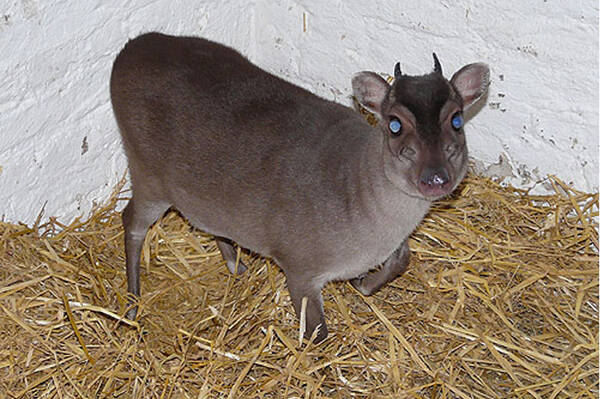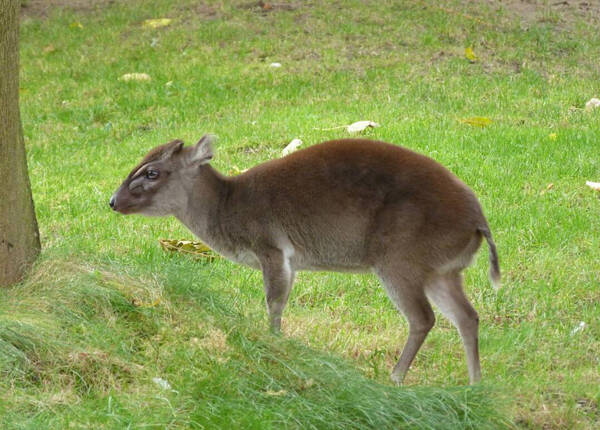Philantomba maxwellii
IUCN
LCBasic Information
Scientific classification
- name:Philantomba maxwellii
- Scientific Name:Philantomba maxwellii,Macartney's gazelle, Macartney's gazelle
- Outline:Ungulata
- Family:Artiodactyls Bovidae Muntjac
Vital signs
- length:63-76cm
- Weight:5-10kg
- lifetime:10-12years
Feature
The smooth fur is a dark blue-grey or grey-brown, with paler underparts and markings on the underside of the neck and belly.
Distribution and Habitat
Distributed in Benin, Burkina Faso, Côte d'Ivoire, Gambia, Ghana, Guinea, Guinea-Bissau, Liberia, Nigeria, Senegal, Sierra Leone, Togo.
It inhabits moist lowland forests, mainly secondary forests and plantations, and more often in riparian forests, small forests and coastal scrub, and in mountain grasslands up to 1400 meters in Sierra Leone. Most of the original habitat of the brown duiker has been destroyed by the development of settlements and agricultural reclamation, but the brown duiker is particularly adapted to dense scrub and farm scrub habitats, and they still survive in local dense scrub or other suitable cover areas. Therefore, it may benefit from the destruction of the original forest by its own good adaptability in disturbed habitats, and it is still widely found in primary and secondary vegetation, and usually survives near settlements.
Appearance
The brown duiker is a small antelope, with females being larger and heavier than males. The body length is 63-76 cm, the shoulder height is 35-42 cm, the tail is 12-15 cm long, and the weight is 5-10 kg. It is slightly hunched, with short front legs, which makes its back look arched. Although this body shape makes it slow to run, it can easily get into the bush. The ears of both sexes are almost vertical, with small pointed horns, extending from the back of the skull, with corrugations at the base, and are about 5 cm long. There is a small tuft of black hair on the top of the head. There are obvious infraorbital glands under both eyes. There are foot glands in the toes, which are composed of a small sac inside the toes, which leads to the outside through a narrow duct. This feature can be used to distinguish the brown duiker from the blue duiker of the same genus, which lacks foot glands.
The smooth fur is dark blue-grey or gray-brown, with paler underparts and stripes on the lower
Details
Brown duiker (scientific name: Philantomba maxwellii) English Maxwell's Duiker, French Céphalophe de Maxwell, German Céphalophe de Maxwell, has 2 subspecies.

The ranges of the brown duiker have set areas with paths through the vegetation around them. Males mark their territories before feeding and resting, which is done by the infraorbital glands, where the secretions of the animals are smeared on conspicuous objects. They often mark their territories and communicate social information in areas where their territories overlap. Muntjacs mark out distinct areas in their territories for defecation, urination, and sleeping.
Muntjacs use their infraorbital glands to mark and distinguish territories from other Muntjacs. Males frequently mark their territories, marking an average of 5.6 objects every 10 minutes when they are most active. Females mark 2.8 objects every 10 minutes. Muntjacs often rub their heads together and rub infraorbital secretions against each other. When a fellow Muntjac is introduced to an established group, territorial marking and head rubbing increase. This suggests that marking is not only a means of declaring territory, but also a means of reinforcing social bonds.
Muntjacs are primarily nocturnal, but in some cases may be active in the early morning, afternoon, and evening. They move in jerky movements and rapidly shake their tails up and down. The species generally stays under the cover of dense foliage, rarely straying beyond 20-30 meters. It lives in pairs. However, in areas where territories overlap or are enclosed, social interactions occasionally occur. Sometimes heads may be rubbed against each other to apply secretions from their infraorbital glands to the body of another duiker. This is most common in male-female interactions, and mutual grooming also occurs in social settings. In addition to infraorbital secretions, duikers can also smell or taste each other's urine. When males collect urine samples from females, they also display limb behavior, characterized by a curled upper lip and an open mouth. It is speculated that duikers are in some way instrumental in helping the animals detect pheromones in urine. Females also collect male urine, but less frequently.

If a brown antelope from another group enters an established group, it usually leads to increased head rubbing between group members and increased territorial marking by males and females. Brown antelopes also usually increase marking when new brown antelopes of the same sex enter their territory. Males will fight with new recruits, ramming each other, butting heads, touching faces, and alternately squeezing the left and right infraorbital glands against each other. These fights end with one of the duikers running away.
The duiker is a herbivore, feeding mainly on leaves of small plants in the forest, such as herbs and shrubs. They rarely graze on grasses, but consume large amounts of leaves of the plants Canthium vulgare, Canthium vulgare, and Alchornea cordifolia. They also eat seasonal fruits that vary with the season. 78 different types of fruit are eaten throughout the year, with each individual consuming an average of about 3 different types of fruit at any given time. Preferences vary with the seasons, for example, during January-February, they prefer poinciana, Nauclea latifolia, figs, stalks of ramie and Balighia sapida. The brown duiker also eats flowers, roots, tubers and fungi of plants, which only make up a small part of the total diet. Occasionally, they also eat ants and young birds. The brown duiker prefers leaves over fruits only during the dry season (also tubers and flowers). There is no seasonal variation in the number of fruit species they eat.
During the courtship period of the brown duiker, males will only form pairs and fully mate with one female, even if multiple females are present. The male sniffs or licks the female's urine, retracts his upper lip and opens his mouth, a behavior that is thought to somehow help the animal sense pheromones and determine the female's sexual state. The courtship of brown duikers is simple, they chase and bite each other. After a period of chasing, the male and female circle each other, and then the male approaches the female from behind and kicks his front legs between the female's hind legs. Mating begins shortly thereafter.

Female brown duikers breed about once a year, giving birth to one calf per litter. They time their mating so that the calves are born during the dry season (January-March) or the "less dry season" (August-September). The gestation period is about 120 days. The birth process lasts 20-30 minutes. After the calves are born, the female will clean them thoroughly with her tongue and eat the placenta and any membranous material attached to them. Newborns are able to stand and walk within a few hours of birth, and can even run within 25 minutes of birth. Newborn calves are hidden by the female in brush or tall grass to avoid being preyed on. The calves add about 50 grams of fat to their bodies every day by drinking milk. After about 2 weeks, the calves can start to forage for themselves and are weaned shortly thereafter, although some calves occasionally continue to nurse until 2 months old. They usually stay with their parents for a year. Females reach sexual maturity at 9-12 months, males at 12-18 months. Lifespan 10-12 years.
The main predatory enemies of the brown duiker are leopards, golden cats, lynx, civets, large birds of prey, crocodiles, pythons, etc. The species has a wide distribution range and is not close to the critical value of vulnerable and endangered species survival (distribution area or fluctuation range less than 20,000 square kilometers, habitat quality, population size, distribution area fragmentation), and the population trend is stable, so it is evaluated as a species with no survival crisis.
Although most of the original habitat of the brown duiker has been modified or destroyed by the spread of agricultural settlements, the brown duiker can still adapt to secondary vegetation and farmland shrubs. Their main threats are widespread use as forest prey and expansion of settlements. The brown duiker is one of the most hunted ungulates in many areas, but has shown significant resistance to hunting pressure, which is better than other antelopes. However, they are not resistant to intensive poaching. For example, in Côte d'Ivoire, rampant poaching has caused the number of brown duikers to decline by more than 90% in 20 years (as of 2001).
Listed in the IUCN Red List of Threatened Species in 2016 ver3.1 - Least Concern (LC).
Protect wildlife and eliminate game.
Maintaining ecological balance is everyone's responsibility!








